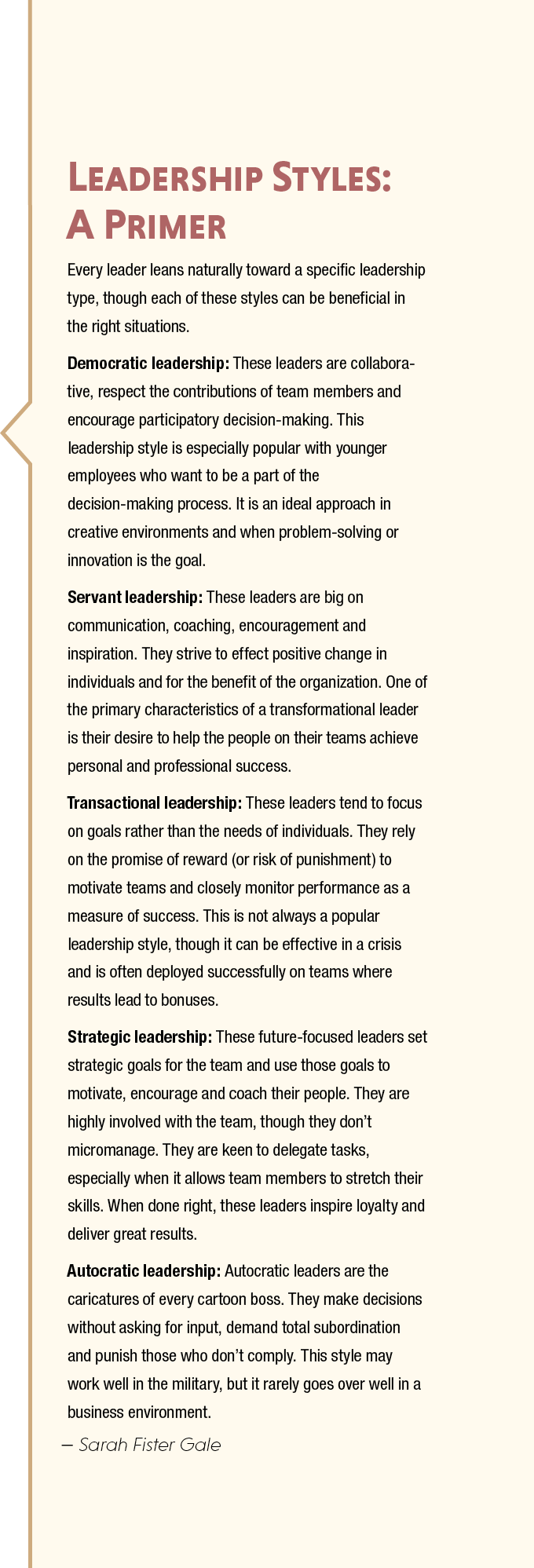
Stop trying to figure out what kind of leader you should be, and focus on what kind of leader your people need.
by Sarah Fister Gale
July 10, 2019
When high performers move into leadership roles, one of the first choices they need to make is what kind of leader they want to be — and there are a lot of options to choose from. Some imagine themselves visionary leaders, ready to guide their teams through rough waters, or democratic leaders who want to encourage collaboration and team decision-making. Others will lean toward transactional leadership, where delivering results is the measure of success.
The truth is all leadership styles can be good choices — in the right situation. Conversely, none of them work all the time. “Trying to label yourself with a single leadership style feels like ’60s-era thinking,” said Greg Githens, a strategic thinking coach with Catalyst and Cadre LLC in Lakewood Ranch, Florida. “Leadership is much more complicated than that.”
“The most successful leaders are able to adapt their leadership style to the situation,” agreed Robyn Benincasa, CEO of World Class Teams and a seasoned firefighter in San Diego. “They become the person their team needs them to be in that moment.”
Situational Leadership
While an inspirational and collaborative leader might be exactly what the team needs if a project calls for creativity and group effort, it can be destructive in situations where decisions need to be made quickly. “If I pull up to a building on fire, the last thing I want to hear from my captain is ‘let’s collaborate on how we should approach this fire as a team,’ ” Benincasa said. In cases of crisis, teams need decisive leaders who can make decisions for the group and inspire their people to follow them.
Leaders who are fluid in their approach are also better able to meet the needs of individuals on the team and their ability to address the tasks at hand, said Ken Blanchard, a columnist for Chief Learning Officer, best-selling author and founder of The Ken Blanchard Cos. “You can’t use one leadership style with every person and expect positive results.”
Imagine, for example, that a leader needs someone to manage the budget for a large project. An “enthusiastic beginner” may require a direct leadership style from a manager who tells them exactly what they need to do to succeed, whereas a “disillusioned learner” may need a supportive leader who is willing to coach them and give them the confidence to make decisions. And a “self-directed achiever” who already has financial experience will benefit from a leader who delegates and trusts them to deliver results.
The lesson, said Blanchard, is that when leaders understand the needs and development levels of their people, they can adapt their leadership style to give them what they need.
Which Way Do You Lean?
This doesn’t mean leaders shouldn’t aspire to a certain style or adopt it as their core strategy. “Every person has a natural leadership style that they grew up with,” Blanchard said. That style — whether it is commanding and assertive or inclusive and affirming — lays the groundwork for the type of leader they are likely to become.
He noted that the DISC personal assessment tool, which assesses users based on personality traits (dominance, influence, steadiness and conscientiousness), can be a good indicator of a person’s inherent leadership style. A company’s mission statement, values and the leader’s own personal point of view can also provide clues, he said.
Although it’s not enough to simply pick a style or to wait and see what emerges naturally. Most leaders benefit from training or mentoring to help them transform their raw leadership skills into a more deliberate approach. Unfortunately, most high performers get little formal training until they are well into their management careers, Blanchard said. “MBA programs don’t teach much about how to be a leader.”
That means many leaders go it alone, adapting their style through a combination of instinct, experience and casual research on the leadership styles that promise the best results. That’s where some leaders can be drawn astray. While we all have an underlying urge to lead one way or the other, the latest business trends can sway the way you lead — or at least how you think you do. Most leaders today will tell you that their approach is democratic or transformational, and that their primary focus is on collaboration, empowerment and giving their people the space to thrive.
It’s a noble description that melds well with current data suggesting employees — especially millennials — seek out collaborative and supportive leaders, and that they aspire to embrace these qualities in their own careers. According to “The Millennial Leadership Survey” conducted by Virtuali and WorkplaceTrends.com, nearly 50 percent of millennials define leadership as “empowering others to succeed” and 63 percent define their own leadership style as “transformational,” which is defined as “wanting to motivate teams to achieve their full potential.”
However, it’s likely their perception is aspirational. “People want to imagine that they are great diplomatic leaders who aim to serve,” said Karlyn Borysenko, an organizational psychologist and chief science officer at RallyBright, a performance management software company. But in reality she estimates that this description only represents about 25 percent of leaders.
Borysenko also noted that people who display diplomatic or service leadership traits on the DISC assessment — which she refers to as “freakishly accurate” — are less likely to be promoted to leadership roles. “It is ironic because they make great leaders,” she said. However, in conventional business settings, people who demonstrate commanding leadership styles are more often viewed as successful.
Be the Leader Your People Need
Instead of trying to become something you are not, our experts suggest leaders find the leadership style that they are most comfortable with — then look for opportunities to stretch their style when the situation calls for it. This can feel uncomfortable, but it’s the best way to see how different styles deliver different results.
When leaders see the business value of trying new leadership styles they are more likely to adopt them where appropriate, Borysenko said. For example, a transactional leader who is always focused on outcomes may have trouble empathizing with a team member who isn’t meeting their goals. Telling them to be more supportive and nurturing isn’t going to change their behavior, she said. “They need to see how paying attention to that person’s emotional needs generates quicker results and greater buy-in.”
For leaders who aren’t sure what kind of leader their team needs, Blanchard made the bold suggestion to just ask them. “A lot of leaders learn a leadership approach but they don’t tell their people what they are doing,” he said. He sees this as counterproductive.
When teams learn leadership styles together and discuss the pros and cons of different approaches, it creates a leadership culture for the team that benefits everyone. Blanchard recalled working with a company that was struggling with extremely high turnover rates. When they started interviewing leaders in the company they found every manager was losing team members but one. When they asked that manager what he was doing differently, he said he spent 15-30 minutes every week talking to every member of the team about the challenges they faced and their goals for the month. It made a huge difference for employee engagement, he said. “Employees just want you to talk to them.”
They also want to know that you have their back — in good times and in bad, said Sean Sandona, CEO of Doorage, a storage company in Chicago. Sandona considers himself a “push leader.” It is his own description for what many leadership consultants would call a visionary or transformational leader — he sets big organizational objectives and then works side-by-side with his people to achieve them. “I don’t tell my people what to do; I get into the trenches and show them,” he said.
While Sandona has a general description for his leadership style, his approach shifts depending on the needs of the client, the task and the team. In the day-to-day workplace he is encouraging and supportive, offering advice and celebrating individual and group success. But when crises hit, he expects his people to follow his lead, even if it means working extra hours or doing unpleasant tasks. For example, Sandona, who also runs a property management company, recently had a condo association client with a broken sewage pipe. “There was two feet of sewage in the basement of the building,” he said. At first his team balked at the idea of cleaning it up, but when Sandona was the first person to walk down those basement stairs, they followed him. “Your people need to know that you will never put them in a situation that you aren’t willing to tackle yourself,” he said.
Similarly, last summer his team wanted to start posting video content to the company website, but nobody knew how to do it. So he and the team stayed late three nights in a row watching every video editing tutorial they could find on YouTube until they figured it out. “It’s a lot easier to say ‘do this’ when I’m doing it too,” he said.
Regardless of the type of leader you are — or aspire to be — the lesson is that there is no single style that will work for everyone and every scenario. “Stop trying to figure out what kind of leader you should be, and focus on what kind of leader your people need,” Blanchard said.
Our experts offered these tips on how to do it.
- Show your team respect and loyalty. If they feel like they can trust you to do the right thing, they will follow your lead, Sandona said.
- Pay attention to what your people need now — not what they needed in the past. “Leaders often confuse experience with expertise,” Githens said. Just because you’ve done something the same way over and over doesn’t mean it will work again or in every situation. “If you are sharp-eyed enough to notice what’s going on, you will recognize what the situation requires.”
- When times are good, get out of the way. “You don’t always need to be out in front to prove you are a leader,” Benincasa said. On good days, she urges leaders to focus on coaching, mentoring and enabling the team to develop their own leadership skills. But on bad days, she noted, you need to take back the reins.
- Leadership is about actions, not titles. “Effective leadership is a journey,” Blanchard said. Regardless of what you call yourself, it is how you respond in different situations that defines who you are as a leader. Being self-aware of your behavior and the effect it has is an important part of that evolution.
Sarah Fister Gale is a writer based in Chicago. She can be reached at editor@CLOmedia.com.




